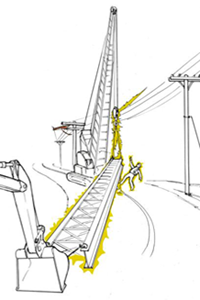Crane hit power line while moving girder
Date of incident: June 2013
Notice of incident number: 2013157620139
Employer: Bridge construction and repair company
Incident summary
A bridge was being demolished and rebuilt. As part of the project, a 140-foot steel girder was being dragged across the old bridge deck by an excavator. Rollers were placed beneath the girder to allow it to roll forward. Every so often, a mobile lattice boom crane was used to lift one end of the girder to allow the rollers to be repositioned. During one of these lifts, the crane came within the limit of approach to an overhead power line at 14.4 kilovolts (phase-to-ground) and made contact with it. Fault current flowed from the power line through the crane components, to the girder, and to the ground. A worker who was in contact with the girder received an electric shock and was rendered temporarily unconscious. He sustained minor injuries including thermal burns.
Investigation conclusions
Cause
- Touching an energized steel girder: The worker received an electric shock from touching a steel girder that had made contact with an overhead high-voltage power line. The electrical fault current travelled through him, rendering him temporarily unconscious and causing minor injuries.
Underlying factors
- Working within limit of approach: The crane or a component of the crane breached the 10-foot limit of approach for working near energized high-voltage power lines.
- Lack of planning: The demolition plan was changed verbally days before the incident. The new plan called for the girder to be moved across the bridge in a narrow corridor with trees on one side and energized power lines on the other. The new plan also meant that a crane would be needed to lift the girder in close proximity to the power lines. The new plan did not take into account the hazards of this arrangement.
- Lack of assurance of compliance with section 19.25 of the Occupational Health and Safety Regulation: Neither the general contractor nor the bridge construction company obtained a written assurance before commencing work with the lattice boom crane in a situation where the limit of approach from the high-voltage power line could not be maintained because of the circumstances of the work or the inadvertent movement of the crane.
- Ineffective supervision: The supervisor for the bridge construction company did not effectively supervise the planning or the work being carried out. He did not ensure the health and safety of the worker or of the other workers under his supervision.
- Failure to follow the health and safety program or the safe work procedure: The bridge construction company did not follow the directives contained in its health and safety program or follow the safe work procedure for working near energized overhead high-voltage power lines, which was included in its own site-specific safety plan. The safe work procedure states that crane work will not proceed before flagging is installed on the line. The employer also did not follow the prime contractor's established safety procedures.
- Lack of an effective system to ensure compliance with the Regulation: The general contractor (which was also the prime contractor) agreed to an unsafe change in the demolition plan and allowed work to take place near high-voltage power lines without knowing if the lines were energized and without first obtaining a written assurance. The company failed to fulfill its responsibilities as a prime contractor.

